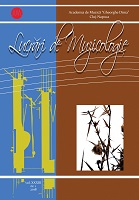Wilhelm Georg Berger: The Fully Chromatic Chorale and the Organ Symphonies
Wilhelm Georg Berger: The Fully Chromatic Chorale and the Organ Symphonies
Author(s): Cecilia Benedicta PavelSubject(s): Cultural history, Music, Recent History (1900 till today)
Published by: MediaMusica
Keywords: moderate modern; systematization; the theory of proportional modes;
Summary/Abstract: This study is focused mainly on Wilhelm Georg Berger’s double vocation as theorist and composer who applies his own theories (like Paul Hindemith, Olivier Messiaen, Béla Bartók or Arnold Schoenberg), in the context of the '60s, when this practice was widespread among the composers of the new “national school” (Anatol Vieru). Drawing mainly on Berger's book entitled Modal Dimensions, a collection of studies published previously in the Muzica [Music] journal, the first part of this research study dwells on the principle whereby Berger attains the supremacy of the fully chromatic chorale, starting from the modal scales. The second part of the study focuses on Berger's work, more precisely on the way he integrates the organ into his symphonies: either as a solo instrument (Symphony No. 10 for organ and orchestra and Symphony No. 18 for string orchestra and organ), or as an accompanying one (Symphony No. 5 “Solemn Music” and Symphony No. 9 “Fantasia”). Finally, the thematic and formal analysis of the two symphonies (Nos. 10 and 18), along with the sources consulted, confirm the label of “moderate modern” attributed to Berger, as well as to other composers whose aesthetic views resonated with Enescu's (Pascal Bentoiu, Nicolae Beloiu, Dumitru Capoianu, Theodor Grigoriu).
Journal: Lucrări de Muzicologie
- Issue Year: 33/2018
- Issue No: 1
- Page Range: 18-27
- Page Count: 10
- Language: English
- Content File-PDF

